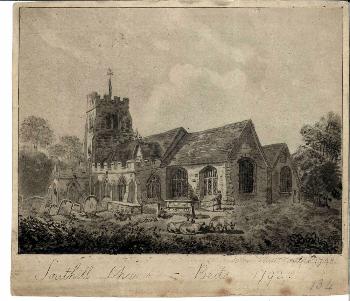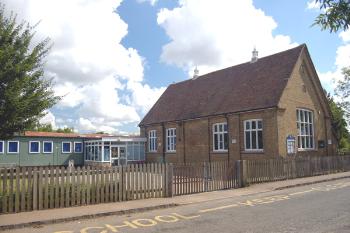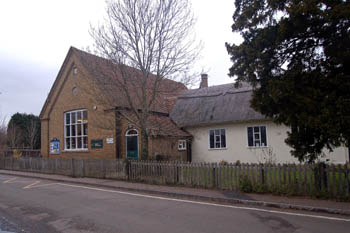Southill School
Early Education
The earliest mention of a school at Southill comes from a somewhat unlikely source – a bastardy bond in the archives of the parish of Dunstable [P72/13/1/1] against a putative father, one Nicholas Day of Southill, schoolmaster. Another 17th century reference is in 1656 in the will of William Daye of Sandy, fellmonger [AD2287] who left an acre of land in Southill, with the schoolhouse, to his second daughter Judith.

Southill church 1792 [X405/23]
Volume 81 published by Bedfordshire Historical Records Society (2002) is a series of episcopal visitations edited by former County Archivist Patricia Bell. At each visitation a list of questions was sent out in advance, one of which enquired about the provision of schools in each parish. The various replies were as follows:
- 1706: "here is a School newly set up for the teaching of 16 poor Children. The Master is very diligent to instruct them in the principles of Religion, but his encouragement is very small";
- 1709: "A Charity Schole has been set up for 12 boys and Girles. They are taught the Church Cateschism";
- 1717: "Here are twenty poor children taught by a school mistress; and from some private contributions";
- 1720: "Here are twenty Children taught by private contributions".
One other 18th century reference which has survived is a settlement certificate of 1762 for Richard Livett, schoolmaster and Hester, his wife, who had come from Willington in the Southill parish overseers’ records [P69/13/1].
In 1818 a Select Committee was established to enquire into educational provision for the poor. This was no doubt prompted, in part, by the recent foundation of two societies promoting education and specifically the building of schools. The Society for Promoting the Lancasterian System for the Education of the Poor was established in 1808 promoting schools run along the lines pioneered by Joseph Lancaster, who had himself copied those of Dr.Andrew Bell, in which older children taught their younger fellows. The Society was renamed the British and Foreign School Society in 1814,. It was supported by a number of prominent nonconformists, Lancaster himself was a Quaker, and sought to teach a non-sectarian curriculum. In answer to this perceived nonconformist takeover of local education the National Society was firmed in 1811 to encourage the teaching of poor children along Anglican lines, including the catechism. The Select Committee sent a questionnaire to all parishes in the country asking for: particulars relating to endowments for the education of children; other educational institutions; observations of parish needs etc. The return for Southill also includes Old Warden, but the two are differentiated. Southill reported that no educational endowment existed but that there were: “six schools, containing each about 20 children, who are taught lace-making and straw platting, and instructed in reading one hour in the day. A Sunday School belonging to the Baptists, consisting of about 140 children…Some children attend a Lancasterian school in the adjoining parish of Shefford”. In those days a Sunday School was just that, a school which met on a Sunday, usually in the church or nonconformist chapel or other similar building, teaching more than the religious topics with which they are associated today.
![Southill School about 1920 [Z1306/106]](/CommunityHistories/Southill/Southillimages/Southill School Z1306-106.jpg)
Southill School about 1920 [Z1306/106]
Southill National School
A National School was created in Southill in 1820, the building accounts being preserved in the Whitbread family archive at Bedfordshire & Luton Archives & Records service [W6066-6071].
In the country generally the number of schools built continued to grow over the next fifteen years so that by 1833 the government agreed to supplement the work of the two societies, and local benefactors, by making £20,000 per annum available in grants to help build schools. It also prompted another questionnaire to be sent to each parish in England asking for details of local educational provision. The return for Southill reads as follows: “Two Day and Sunday Schools; in one 30 attend daily [presumably the National School], and 31 on Sundays, supported by an annual collection; in the other 13 attend daily and 202 on Sundays; this is supported by Baptist Dissenters: also a few Daily Schools, in which about 30 children are taught to read, plait and make Lace”. The National School, like the vast majority in the county, had trouble ensuring attendance from pupils as other, more pressing, economic needs took them elsewhere, as a letter of 1839 [X25/28] notes: “School deserted for the plait trade”. The parish archives contain a list of poor people whose children’s schooling was paid for in 1834 [P69/18/9]; the names of the fathers (usually) and ages of their children (only those under ten being schooled) are given below.
James Massey – 3, 6, 11, 15, 17, 19
John Cowland - ½, 3, 5, 7, 9, 11, 13
James Usher – ¼, 5, 8, 11, 14
William Sims – 2, 5, 7, 9, 14, 18
S Rowkins – 2, 6, 10, 13, 16, 20
William Manson – 4, 9, 13, 15
William Finch – 1, 3, 5, 7, 9, 11
John Clifton – 2, 5, 7, 9, 11, 13
John Wheatley – 1, 3, 5, 7, 9, 11, 13
John Breed – 7, 9, 13, 14, 21
John Endersby – 3, 6, 9, 12, 15, 17, 20 “One aged 17 Deaf and Dumb”
Thomas Honey – 1, 3, 5, 7, 8, 10, 12, 14, 17
Benjamin Taylor – ½, 3, 5, 8, 12, 16, 18
Thomas Bland – 1, 3, 5, 7, 11
Widow Jeffrey – 9, 13, 15, 16, 19
Joseph Green – 5, 7, 8, 10, 15, 18
Henry Edwards – 3, 6, 9, 11, 13, 16, 18, 20
William Millard – 3, 6, 8, 11, 14, 19, 21
William Barns – 2, 11, 13, 15
William Handscomb – 1, 4, 9, 11, 14, 17
Thomas Crouch – 1, 4, 6, 8, 10, 12, 15, 20, 21
William Breed – 1, 3½, 6, 8, 14, 18, 20, 22
William Huckle – 1, 4, 6, 8, 10, 14, 17
John Smith – 1, 6, 9, 12, 16, 24
James Green – 4, 6, 8, 10, 18, 20
Cox – 10, 11, 15, 18
Benjamin Litchfield – 5, 9, 12, 15
The next national enquiry was in 1846/7 when the Church of England made an enquiry as to all its church schools. This was against the background of a new Whig government which championed secular education and the increasing importance of nonconformists, particularly Wesleyan Methodist, and Roman Catholics in providing schools. The return for Southill noted a Sunday School for 89 boys and 87 girls and a daily school, obviously the National School, for 40 boys and 50 girls.
The first Education Act was passed in 1870 (more correctly it was known as the Elementary Education Act). It was a milestone in the provision of education in Britain demonstrating central government's unequivocal support for education of all classes across the country. It also sought to secularise education by allowing the creation of School Boards. These were groups of representatives, elected by the local ratepayers and the Board had the powers to raise funds to form a local rate to support local education, build and run schools, pay the fees of the poorest children, make local school attendance compulsory between the ages of 5 and 13 and could even support local church schools, though in practice they replaced them, turning them into Board run schools (known as Board Schools). Naturally, and luckily for local historians, the Act required a questionnaire of local schools in 1870; the Southill return notes that Southill School accommodated 221 children and that a Church of England Private School in the village accommodated 52 infants.

Southill Lower School July 2007
Southill Public Elementary School
A land mark Education Act was passed in 1902, coming into effect in 1903. It disbanded the School Boards and gave day to day running of education to newly formed Local Education Authorities, usually the county council, as in Bedfordshire. The old Board Schools thus became Council Schools whilst the old National, British and other non-Board schools became known as Public Elementary Schools. Naturally, Southill became a Public Elementary School.
Bedfordshire & Luton Archives & Records Service has a scrapbook of cuttings of visits made to most Bedfordshire Schools by School Inspectors for a period from just before the First World War through the inter-war years [E/IN1/1]. The first of these reports was in 1910, when average attendance was 92: "The school is in very good order and the work, which is very uniform in quality, is on the whole satisfactory. The children in the lower classes should be trained to speak more audibly". By 1913 average attendance had risen to 103 and it was noted: "Order and tone are very praiseworthy and in all classes good work is done…The children are bright and evince considerable interest in their work. The Infants' Class continues to be kindlt, carefully and successfully taught. All the seats used by these little children should be provided with back-rests".
The first recorded inspection after the Great War came in 1922 when average attendance had risen again to 116 and the long term effects of the War were still making themselves felt. It noted: "The Head Teacher of this School has had difficulties with which to contend, as it has been seriously unbderstaffed for some time. Morevover the Entrants from a small school which closed last year [Stanford] as wel las those who come from a Contributory Infants' School [Broom] are not so well advanced in attainments as the children who have begun their school life here". Not all was gloomy, however: "There are several points worthy of commendation: the order in School, the neatness and cleanness of the written work, the grounding of the Infants - although this is partly accomplished by rather formal methods - the Gardening, for which the School has long been well known, the work of the Supplementary Teacher in charge of Standards II and III and the general influence of the Head Teacher, are good". The inspector went on: "The Teaching has now, however, become somewhat lifeless". After some specific points the inspector concluded: "It is strongly advised that the Head Teacher should spend a few days in good schools so that he may revise his methods and raise his standard of effort". An inspection the following year (average attendance 134) noted: "Although some of the recommendations in the last report for the improvement of the school have been adopted, one or two of the most vital have been neglected". The inspector was particularly concerned at the weakness of arithmetic and "distinctness of speech", the work of the Infants' Department was praised, however.
A change of blood was obviously called for, since in 1926 the inspector reported: "This school has made marked improvements under the new Head Master in every way. The attitude of the children to their work has completely altered: they are now keen and responsive. The school should be a very good one before long". In 1929 the inspector was happy to report: "The early promise that the Head Master gave of making this into a successful school has been amply fulfilled. His general supervision including the inspection of the teachers' notes and records, his examinations and his reports are thorough. The issue of cyclostyled lists of marks to each child has had a stimulating effect. - Four scholarships were gained last year".
This happy state of affairs continued for in 1932 the inspector noted: "This school is in a very satisfactory condition as regards both the instruction by the Teachers and the work done by the children". The final report in the scrapbook, for 1934, revealed that the Head Master had gone, presumably onto greater challenges: "The recently appointed Head Master is eminently suitable for his position in the village. the premises have been improved in various ways - lighting, natural and artificial, new offices [toilets] and new flooring. The previous experience of the Head Master, particularly on the Physical Training and artistic sides, has enabled him to give an extra touch of interest to the work, excellent in many ways as I twas, which was characteristic of the school under its previous Head Master. The children are responsive; the teachers are working well; the Head Master's recognition of these factors, as well as the support of managers and Parents, gives every reason to believe that the school, under his direction, will be very successful".

Southill Lower School from the east March 2008
Southill County Primary School
The third of the great Education Acts was that of 1944 which established the principle of County Primary Schools for children up to the age of 11, at which time they took an examination to determine the nature of the secondary school they would attend until they were 15, the most academically able going to grammar schools, the rest to secondary or secondary modern schools. The act also created two types of successor to the public elementary schools - the Voluntary Aided and Voluntary Controlled schools. Voluntary Aided schools are those in which the Local Education Authority funds the school but the governing body is independent. Controlled schools own their own buildings whilst the staff are employed directly by the governors. Unusually, Southill school moved from being a Public Elementary to a county primary school without becoming either voluntary aided or voluntary controlled.

Southill Lower School from the west March 2008
Southill Lower School
In the 1970s Bedfordshire County Council introduced comprehensive education, doing away with the 11+ examination and grammar schools and introducing a tier of school between the old County Primary and County Secondary Schools. Thus Lower Schools now taught children aged 4 to 9, Middle Schools from 9 to 13 and Upper Schools from 13 onwards. Southill County primary, as may be expected, became Southill Lower School and, as of 2007, is still held in the 19th century building, albeit with modern portacabins attached.